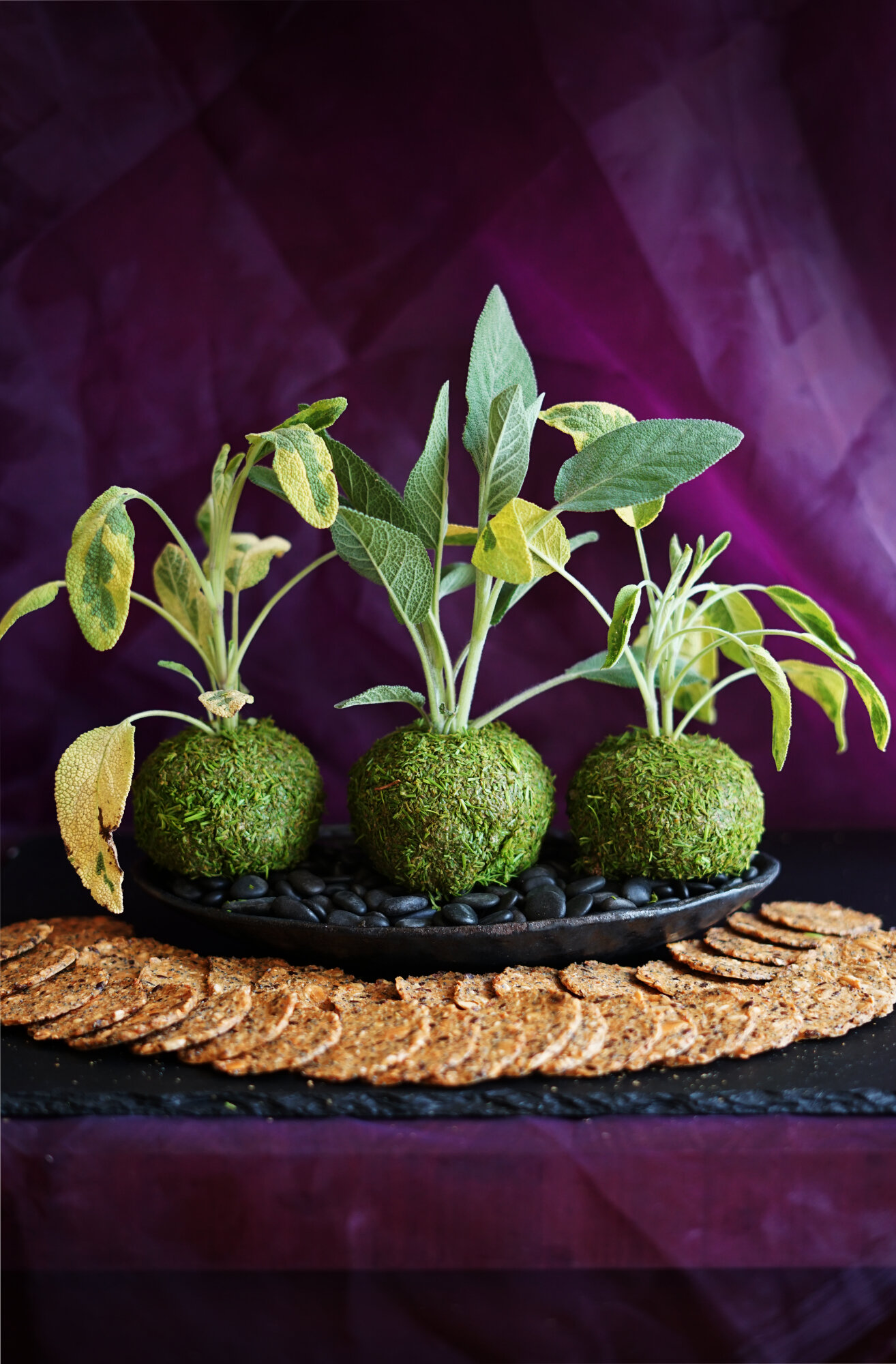Kokedama-Inspired Savory Delights: Conifer Tip and Black Garlic Cheese Balls
New to foraging? Learn more about ethical and safe foraging (plus how to get started) here!
As an outsider, I find the culture of careful creation and natural influence in Japan to be deeply inspiring. This culture seems to be deeply rooted in tradition and craftsmanship, while also being incredibly innovative. I could go on about architecture, art, and design… but what really gets my heart pumping are the ways the Japanese culture embraces plants.
What a beautiful balance they have found between structured and organic, perfect and imperfect. From Ikebana, the art of flower arranging using structure and careful minimalism; to the Bonsai art form of growing trees in miniature form with careful trimming and care; to the newer art of Kokedama, where root balls are encased in soil and moss to form beautiful hanging mossy orbs with plants growing from them: plants are presented in an elevated and profoundly beautiful way.
I was lucky enough to take an Ikebana class while in college. I had seen a little listing on a bulletin board in the Asian part of town and it sounded like an adventure I had to take! I think I was the only non-Asian attendee, but I was completely enchanted and felt welcome by the community, who seemed enthusiastic to share their culture graciously with an eager outsider. I was entranced as the instructor explained that ikebana was not just simply placing seasonal flowers into a vase (or going for a lavish and thickly-packed selection as is so popular in Western Europe and the U.S.) Rather, ikebana is about highlighting just a couple of seasonal plants in a sculptural and carefully-balanced way. Ikebana was originally developed as part of the ceremonial tea culture, and the ritual of creating the display was woven into the careful and deliberate preparation of the space. These arrangements are highly seasonal and created with an emphasis on form. Ikebana gives the plants displayed the space to breathe and echo the beauty of the natural world. It is seen and practiced as an art form; understanding the subtleties of preparing a really special arrangement take many years to learn. Ikebana masters dedicate their life to this pursuit.
Bonsai has many similarities: carefully trimming a plant’s roots and branches to tame it into a miniature version of itself. These versions are not symmetrical or rounded or controlled beyond their form, however; a Juniper bonsai holds the same twisting trunk and branches and beautiful asymmetry that a full-grown version does. The detail of the pot and filler are important factors of the design as well.
Kokedama is actually a newer form of Japanese plant art. It has its roots in certain styles of bonsai, but has become its own artform and expression. As this interesting website explains:
“Literally translated, ‘koke’ means moss and ‘dama’ means ball. The original Japanese forms of kokedama had miniature sculptured bonsai trees displayed on handmade potter or pieces of driftwood. They encapsulated the Japanese aesthetic of Wabi-sabi, an appreciation of the imperfections of nature and the transience of natural beauty. The characteristics of Wabi-sabi include simplicity, warmth, earthyness, irregularity, roughness, naturality, acceptance, and observation. Kokedamas are created as a reflection of Wabi-sabi principles.”
Oh how I adore that complexity and balance, that duality of careful precision and organic design! Clusters of hanging kokedama or balls carefully perched on rounded river stones have become a trend in the interior design world, but they are so much more than a pretty accent piece. They are a reminder of the perfect imperfection of the natural world, and that balance can be sought in many different ways.
Kokedama Cheese Ball:
Though this recipe is far from anything remotely resembling Japanese tradition, I believe that it displays the same tenets of Wabi-sabi as described above. This savory treat is seasonal; its “mossy” coating is actually fresh green fir or spruce tips. I love walking in the woods to forage for these. The bright light green against the darker evergreen old growth makes the trees look strangely illuminated, as if decorated with magical fairy lights. I take just a couple from each tree, leaving plenty to allow the tree to continue growing big and strong. These young evergreen tips are much milder than mature needles; in fact, they often taste refreshingly like citrus to me! The flavor they impart to this recipe is bright and energetic, the perfect counterbalance to the earthy cheese filling. It’s surprisingly easy to make a creamy cheese out of goat milk, which is then supplemented with briny and rich chopped olives and black garlic. If you have never tasted black garlic, you’re in for a treat! This is garlic that has been held at a specific temperature for a long period of time, allowing it to slightly caramelize and break down. The resulting black garlic cloves are rich, earthy, and full of tangy umami. They are entirely without the bite of fresh garlic and have a delightful flavor slightly reminiscent of aged balsamic vinegar or even molasses. Pairing those rich earthy flavors with freshly foraged conifer tips creates a delicious edible interpretation of Wabi-sabi and the art of kokedama. I like to display these on natural slabs of clean wood or stone so that they resemble the careful arrangements that inspired them.
Ingredients:
½ gallon fresh goat milk
⅔ c. fresh lemon juice
1 tsp. Salt
1 large shallot, finely diced
1 head of black garlic, peeled and mashed into a paste
½ c. flavorful black olives, pitted and finely diced
¼ tsp. Salt
1 tsp sriracha
3 c. fresh conifer tips from edible and clean trees (I like fir and spruce.)
Durable herbs or edible flowers with woody stems to stick into each ball.
Directions:
In a medium saucepan, heat milk to 180F. While it’s heating, mix the lemon juice and salt in a small dish. Once the milk reaches temperature, remove it from heat and immediately stir in the lemon juice mixture. Only stir a couple of times, then leave the mixture to sit for 5 minutes.
Line a sieve with 4 to 5 layers of cheesecloth and pour mixture through it. Drain for 1 to 2 hours over a large bowl, making sure that the cheesecloth won’t be covered by the whey draining below it.
Once the cheese has drained for a couple of hours, squeeze out any remaining moisture, then put the cheese into a bowl. Mix in the rest of the ingredients, except for the conifer tips. Chop those finely while the cheese is draining.
Roll the cheese into three even balls, then roll them in the chopped conifer tips. Wrap each in plastic wrap and refrigerate for at least two hours (or overnight.) Unmold onto a serving plate and stick an herb in the top to look like a plant. Serve with chips or crackers.
Love what you’ve read here? Don’t forget to Subscribe to get frequent updates of new posts!
Huge thanks to my Patrons that make sharing all of these lovely posts with you possible (without all of the pop-ups and ads that make browsing other blogs so annoying). If you’re feeling generous, you too can support the wonder with a monthly contribution of your choice. Even $1 helps a lot! Your donation will help to fund this blog as well as my surprise free events and gifts for strangers. Learn more about this program at the link below:



















Join me for a little winter night magic as we bake this cake full of rich seasonal flavors and black cocoa!